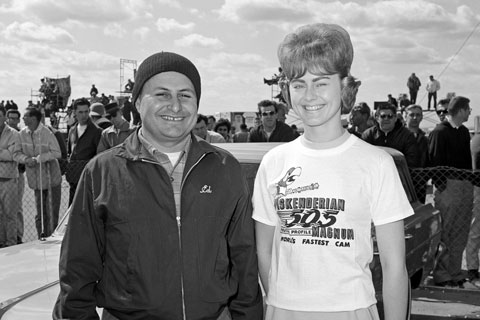SEMA News—April 2015
HERITAGE
By Drew Hardin
Photo Courtesy Petersen Archive
Tricks of the Trade
 The equipment may have changed, but many of the tips laid out in this October 1964 Car Craft magazine story on “Photographing Cars” are still worthwhile for anyone interested in taking better pictures of their cars (or trucks, hot rods, customs, sports cars, motorcycles, you name it).
The equipment may have changed, but many of the tips laid out in this October 1964 Car Craft magazine story on “Photographing Cars” are still worthwhile for anyone interested in taking better pictures of their cars (or trucks, hot rods, customs, sports cars, motorcycles, you name it).
The date on the photo job for this story was July 1964, making the subject Mustang a new car. The California hard license plate and Galpin Ford plate frame suggest that it was not a press vehicle but instead belonged to one of the staffers, as does the fact that the galloping pony and its corral have been removed from the grille.
Bud Lang’s article addresses camera gear (and the need for a “flash gun and bulbs” along with the camera and film), finding an uncluttered location and how the front-three-quarter and rear-three-quarter views of the car are best, as they show both the front and side—or rear—of the car at once.
In the photo, our loafer-wearing staffer is demonstrating how to hold the camera for a high-angle photo, which “works exceptionally well with roadsters” and “wipes out the background” to minimize distractions, wrote Lang. Look closely, and you’ll see that the camera is upside down—a trick to gain a few more inches in altitude and still allow the shooter to look through the viewfinder to compose the shot. Other photos in the story showed the pros and cons of shooting the car with the camera at waist level and close to the ground—an angle that makes the car look like it’s “ready to leap off the page.”
Lang’s tips for lighting are very rudimentary: Put the sun at your back so that the car is “fully lighted”; don’t shoot the car at high noon (though from the looks of the shadows in the story, this was a midday shoot); and “do not attempt pictures in the early morning or late afternoon when the shadows are long. Your exposure may be off because of the rapidly changing light, and you will have difficulty keeping your own shadow out of the way.”
Lang made no mention of taking advantage of the beauty light that occurs at dawn and dusk, but the flash equipment he referred to could add light to shadowed areas in engine compartments, interiors, trunks and even outside to brighten chrome.
This article predates the widespread use of 35mm cameras, so much of Lang’s advice is aimed at those who had cameras shooting 120 or 620 film: “Unless you have a light meter and understand its use, take your exposure information directly from the manufacturer’s instruction sheet that comes with every box of film. Make sure your lens is clean. Never wipe it with your finger, shirt tail, handkerchief, or Beatle wig.”
It was 1964, after all.






